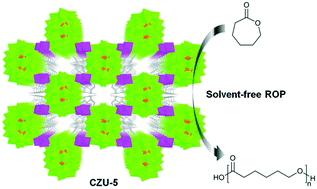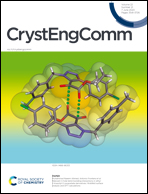An unprecedented cobalt(ii)-containing Wells–Dawson-type tungstovanadate-based metal–organic framework as an efficient catalyst for ring-opening polymerization of ε-caprolactone†
Abstract
By utilizing a flexible fluorinated bis(triazole) ligand 1,4-bis(1,2,4-triazole-1-ylmethyl)-2,3,5,6-tetrafluorobenzene (Fbtx), a thermally and chemically stable cobalt(II)-containing tungstovanadate-based metal–organic framework (MOF) {[Co3(Fbtx)5(V2W18O62)(H2O)2]·26H2O}n (denoted as CZU-5) was synthesized and structurally characterized. The X-ray structural analysis revealed that CZU-5 features a three-dimensional (3-D) self-penetrated α-polonium cubic structure, which results from a 3-D 4-fold interpenetrated diamondoid [Co(Fbtx)]n network connected by the Wells–Dawson-type tungstovanadate clusters. Unexpectedly, the introduction of vanadium atoms as heteroatoms into the Dawson-type anion in polyoxometalate (POM)-based coordination polymers has not been reported to date. For the first time, the POM-based material was demonstrated to be an effective catalyst for the solvent-free ring-opening polymerization of ε-caprolactone. Moreover, the CZU-5 catalyst could be recycled up to five times with the retention of both catalytic activity and crystal structure.



 Please wait while we load your content...
Please wait while we load your content...